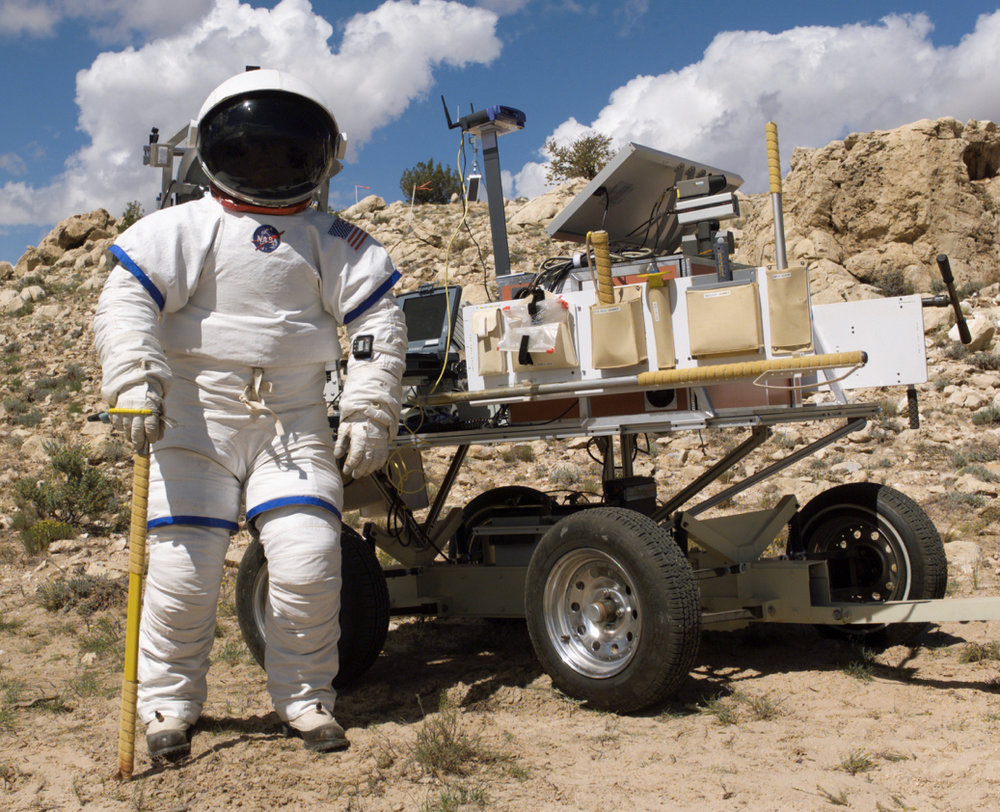Human Performance
Extreme Environments & Extravehicular Activity (EVA)
What are the limits of human performance on Earth and in space? How can we augment them? Our work has involved:
Characterizing the energetics and optimality of gait under Earth gravity and in reduced gravity
Developing new space suit technologies
Optimizing path planning for extravehicular activity (EVA)
Wearable computing & situational awareness
This work has been focused on, but not limited to, enabling human planetary exploration. Space-suited activity is critical for human spaceflight and is synonymous with human planetary exploration. For my doctoral work, through the present, I have studied how space suits impact the bioenergetics of gait and how improved suits might be developed. Below are selected outcomes of this work. This work was done mainly in partnership with Prof. Dava J. Newman and other colleagues in the Human Systems Lab (formerly the Man Vehicle Lab) at MIT. I also contributed to fundamental aspects of the Biosuit project.
Wearable Computing for use in Space Suits
WearSAT, or Wearable Situational Awareness Terminal, was a joint project between MIT, Boeing, and the Media Lab, with support from Hamilton Sunstrand. Long before Google Glass, we examined use of wearable displays to facilitate information delivery to space suited astronauts.
Carr CE, Schwartz SJ, Rosenberg I. A Wearable Computer for Support of Astronaut Extravehicular Activity. Proceedings of the 6th International Symposium on Wearable Computers. IEEE. Seattle, October, 2002. doi: 10.1109/ISWC.2002.1167215
Hodgson, E., Sidgreaves, R., Braham, S., Hoffman, J., Carr, C., Lee, P., Marmolejo, J., Miller, J., Rosenberg, I., Schwartz, S., Requirements and Potential for Enhanced EVA Information Interfaces, 33rd International Conference on Environmental Systems, Vancouver, Canada, 2003. SAE paper 2003-01-2413. doi: 10.4271/2003-01-2413
Carr CE, Schwartz SJ, Newman DJ. Preliminary Considerations for Wearable Computing in Support of Astronaut Extravehicular Activity. MIT Media Lab Technical Report # 551 (2001). http://hd.media.mit.edu/tech-reports/TR-551.pdf
Optimizing Extravehicular Activity Traverses
Load-carrying models and other metrics such as surface visibility can be used to optimize planetary extravehicular traverses.
Carr, C.E., Newman, D.J., and Hodges, K.V., Geologic Traverse Planning for Planetary EVA, 33rd ICES Conference, 2003. SAE paper number 2003-01-2416. doi: 10.4271/2003-01-2416
Bioenergetics Modeling & Historical Data
We gathered historical data from space suited and unsuited locomotion studies and identified the main factors that determine the bioenergetics of movement. We also created a systematic approach to characterize movement bioenergetics using a simple model and related this model to the chemistry and molecular biology of muscle dynamics.
Carr CE, Newman DJ. Space Suit Bioenergetics: Cost of Transport During Walking and Running. Aviat Space Environ Med 2007; 78(12):1093-1102. doi: 10.3357/ASEM.1953.2007.
Carr CE, Newman DJ. Space Suit Bioenergetics: Framework and Analysis of Unsuited and Suited Activity. Aviat Space Environ Med 2007; 78:1013-1022. doi: 10.3357/ASEM.1952.2007.
Energy Optimal Gait in Low Gravity
We demonstrated through modeling and experimentation that, on the Moon, running is more efficient per unit distance than walking. Later work also demonstrated that loping (like skipping without changing feet) is an optimal gait under low gravity conditions.
C.E. Carr and D.J. Newman. When is running more efficient than walking in a space suit? 35th ICES Conference 2005. SAE Transactions Journal of Aerospace, 114 Jul 2006. SAE paper 2005-01-2970. doi: 10.4271/2005-01-2970
Rader AA, Newman DJ, and Carr CE. Loping: A strategy for reduced gravity human locomotion? In 37th International Conference on Environmental Systems, Chicago, IL, July 9-12, 2007. Society of Automotive Engineers, Warrendale, PA, USA. SAE paper 2007-01-3134. doi: 10.4271/2007-01-3134
Exoskeleton Energetics: Space Suits As Springs and Optimal Space Suit Mass
We demonstrated how space suit legs behave as springs, and use this to understand when and how space suits can help support their own weight, with implications for the mass of space suits needed for future exploration such as on Mars.
Carr CE, Newman DJ. Exoskeleton Energetics: Implications for Planetary Extravehicular Activity. Aerospace Conference, 2017 IEEE. March 4-11, Big Sky, Montana. Session 8.06 Space Human Physiology and Countermeasures. Paper # 2354. doi: 10.1109/AERO.2017.7943712, Author Manuscript.
Carr CE. Optimal Space Suit Mass for Mars Extravehicular Activity. Aerospace Conference, 2016 IEEE, March 5-12, Big Sky, Montana. doi: 10.1109/AERO.2016.7500869
Carr CE, McGee J (2009). The Apollo Number: How space suits affect the walk-run transition. PLoS ONE 4(8): e6614; doi: 10.1371/journal.pone.0006614.
Carr CE, Newman DJ. Characterization of a lower-body exoskeleton for simulation of space-suited locomotion. Acta Astronautica 62 (2008) 308-323 (doi:10.1016/j.actaastro.2007.11.007).


